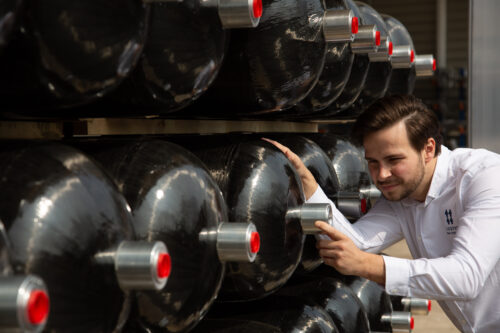US & Asia-Pacific +1 800 764 0366 | Europe & Middle East +44 (0)115 980 3800
By Lewis Anderson, Head of Transformational Projects
Decarbonising the transport sector is vital if the UK is to meet its net zero ambitions, and hydrogen fuel systems have a key role to play. The transportation sector is a major contributor to greenhouse gas emissions – it produces around a quarter of the UK’s total emissions each year – posing a significant challenge to achieving the country’s net zero goals. While electric vehicles are gaining traction, hydrogen offers another promising solution for a cleaner future.
Beyond its well-established use in powering buses, trains, trucks, and off-road vehicles, hydrogen is attracting increasing interest from the maritime, rail, and aviation industries. However, these sectors present unique challenges due to varying regulations and infrastructure needs. For instance, maritime and aviation applications require more complex solutions compared to on-road transportation. Rail, on the other hand, faces operational, commercial, and design-related hurdles.
Bridging the infrastructure gap
Significant progress has been made in developing safe and efficient hydrogen transportation systems for road use. However, one key barrier remains: the lack of widespread fuelling infrastructure.
The solution? Investing in a comprehensive network of hydrogen fuelling stations across the UK. While identifying potential hydrogen projects with a capacity of 27GW is a positive step, continued efforts are crucial to drive hydrogen access and uptake.
One way to bridge the infrastructure gap is through bulk gas transport systems (BGT) or ‘virtual gas pipelines. These systems connect hydrogen production and consumption points, enabling operators to decarbonise transport while facilitating the movement of the clean gas in a scalable manner.
Virtual pipelines offer a valuable stepping stone until dedicated pipeline infrastructure is established. While they can provide temporary or permanent solutions in the long term, – the future likely involves a combination of physical and virtual pipelines, catering to specific needs across the supply chain – they offer a flexible option for moving hydrogen to where it is needed in the short term.
Hydrogen cylinders: Choosing the right storage solution
The type of hydrogen cylinder used in transport plays a critical role. The most common choices are Type 3 and Type, each offering unique benefits:
Type 3 (aluminium lined): Robust, fast-filling, and non-permeable, making them a popular choice for pioneers and original equipment manufacturers (OEMs).
Type 4 (plastic lined): Lightweight with high storage volumes, providing a cost-effective solution for long-range applications in rail, boats, and other vehicles. However, Type 4 cylinders might require pre-chilling of hydrogen before filling due to heat generation during filling.
The ideal choice of hydrogen cylinder depends on the specific application and user priorities. Type 3 cylinders offer superior durability, while Type 4 prioritises weight reduction.
Pioneering hydrogen fuel systems
For over 125 years, Luxfer Gas Cylinders has been a leader in gas containment. Building on this experience, we’ve dedicated over two decades to developing hydrogen fuel systems for diverse transport applications, including buses, trucks, trains, marine vessels, and refuse vehicles.
Our lightweight, high-pressure storage systems have been instrumental in groundbreaking projects like the world’s first hydrogen double-decker buses, the UK’s first hydrogen train, and the first hydrogen-powered crew transfer vessel for North Sea wind farms.
While hydrogen isn’t a one-size-fits-all solution, it is a crucial piece of the decarbonisation puzzle. By enabling rapid carbon reduction, hydrogen has the potential to transform the transport sector and propel the UK towards net zero emissions.
